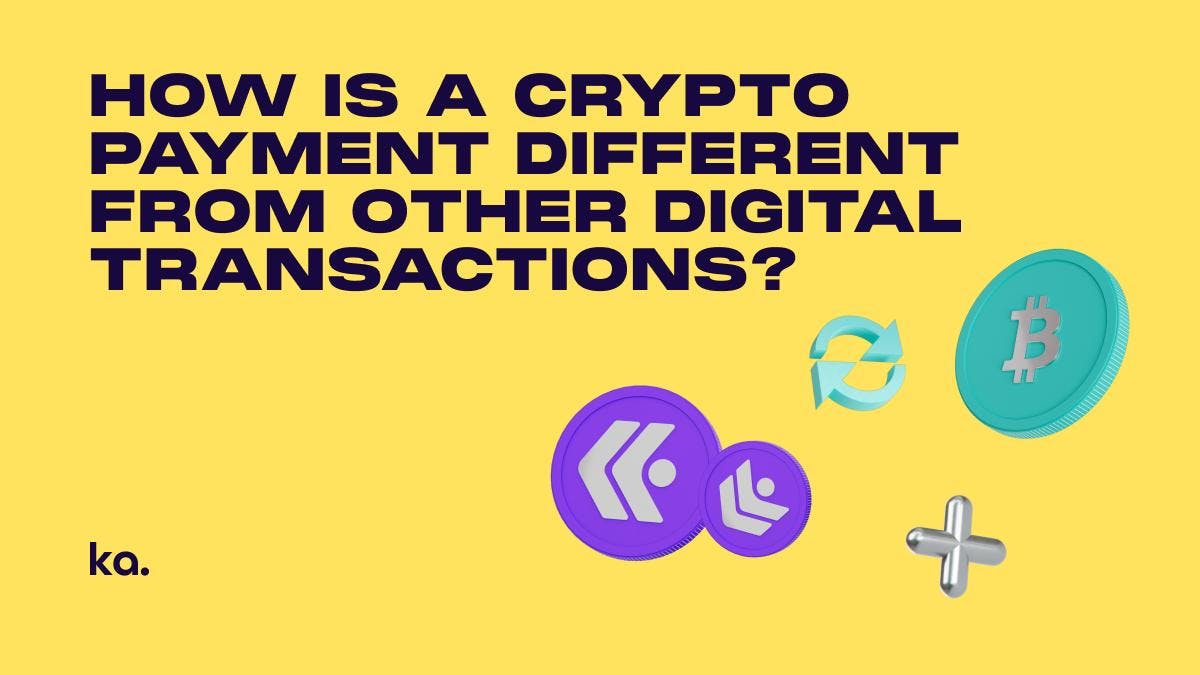Stablecoins play a huge role in the crypto market, serving as a bridge between the traditional financial system and the crypto realm.
Since most cryptocurrencies are volatile, traders and investors find it hard to predict market movements and manage their risks. Stablecoins offer a way to mitigate this risk by providing a more stable investment option.
What Is a Stablecoin?
A stablecoin is a type of cryptocurrency with a steady and predictable value. Unlike other cryptocurrencies, which may experience sudden price swings, stablecoins are usually pegged to an asset like cash (a.k.a. fiat currency) or a commodity. Therefore, their value remains relatively stable.
Stablecoins aim to offer the best of both worlds: the convenience and efficiency of a digital currency combined with the stability of cash.
4 Types of Stablecoins
There are four main types based on how they're designed to maintain a stable value:
1. Fiat-backed stablecoin
This type of stablecoin is backed by a traditional, government-issued currency, like the U.S. dollar or euro. Essentially, for every unit of the stablecoin in circulation, there is a corresponding unit of cash held in reserve to support its value.
Some of the most popular fiat-backed stablecoins in the crypto market include Tether (USDT) and USD Coin (USDC), both of which are pegged to the U.S. dollar.
2. Crypto-backed stablecoin
The value of these stablecoins is linked to the value of an underlying cryptocurrency, such as Bitcoin (BTC) or Ethereum (ETH). For example, if a cryptocurrency-backed stablecoin is pegged to the value of BTC, one token represents 1 BTC.
3. Commodity-backed stablecoin
The value of this type of stablecoin is directly linked to the value of the underlying commodity, such as gold, silver, or oil. Its value is tied to the value of the underlying commodity, which provides a level of stability and predictability.
4. Algorithmic stablecoin
This type of stablecoin is designed to maintain a stable value using a computer algorithm rather than being backed by cash or a commodity. The algorithm used by the stablecoin is designed to automatically adjust the supply of the stablecoin in response to demand fluctuations in order to keep the price stable.
For example, if the price of the stablecoin is above its target value, the algorithm might automatically issue more tokens to increase the supply and bring the price back down. Conversely, if the price is below its target value, the algorithm might reduce the supply by burning tokens to increase demand and bring the price back up.
Because algorithmic stablecoins aren't backed by an external asset, they can be more flexible and adaptable than other types of stablecoins. However, they can also be more complex and risky, as their value is ultimately determined by the algorithm's ability to maintain price stability in a constantly changing market.
What Are Stablecoins Used For?
The most common uses cases of stablecoins include:
1. Trading
Many volatile cryptocurrencies are paired with stablecoins for trading, also known as trading pairs (e.g., KASTA/USDT). This provides a more stable value to trade with than if they’re using other volatile cryptocurrencies.
Also, stablecoins make it easier for traders to switch to a more stable asset during a dip or a bear market. For example, if you’re a BTC holder you can convert some of your assets to USDT to keep your gains or avoid huge losses during the bear season.
2. Remittances
Many users prefer fiat-backed stablecoins for cross-border payments and remittances because they’re kind of like cash, but can be sent much quicker and with way lower fees than traditional payment methods.
3. E-commerce
Stablecoins are easy to use for online purchases and e-commerce transactions, as they provide a stable value that is easy to convert into other currencies.
4. Decentralized Finance (DeFi)
In the DeFi space, you can use stablecoins as collateral for loans, to provide liquidity for decentralized exchanges, and offer a stable value for decentralized savings accounts
5. Value Storage
Stablecoins provide a way to store value in a cryptocurrency that is not subject to the volatility of other cryptocurrencies, making them an attractive option for those looking to protect their assets.
How Do Stablecoins Work?
As mentioned in the stablecoin definition, it works by trying to maintain a stable value, usually against an external asset like cash or a commodity. This is different from other cryptocurrencies like BTC, whose values can fluctuate wildly based on supply and demand.
To achieve this stability, stablecoins use various mechanisms, depending on their type. For example, a fiat-backed stablecoin would be backed by cash like the euro, so for every unit of the stablecoin in circulation, there would be a corresponding unit of cash held in reserve to support its value.
Top 4 Benefits of Stablecoins
Some of the main benefits of stablecoins include:
1. Quicker transaction times
Sending and receiving stablecoins are processed on a decentralized network of computers that work together to verify and confirm the transaction. And with no intermediaries, banks, or financial institutions involved, transactions are usually completed much faster.
Also, stablecoins can offer near-instant settlement times because they operate 24/7. This means that you can send and receive payments at any time, without having to wait for banks or other institutions to be open. In Ka.app for instance, you can send USDT to another user in just a few seconds.
2. Less cost on cross-border transactions
When you send a traditional payment, such as a wire transfer, you may be charged fees by your bank, the recipient's bank, and other intermediaries involved in the processing and verifying of the transaction. These fees can add up and make the international transaction more expensive.
In contrast, when you send a stablecoin, you may only be charged a minimal transaction fee that goes towards verifying and confirming the transaction on the decentralized network. Since stablecoins operate without intermediaries, the fees are typically much lower than those charged by traditional payment systems.
3. Accessibility
Stablecoins can be used by anyone with an internet connection, regardless of their location. This can make it easier for people to participate in global commerce and send money across borders.
4. Little to zero volatility
Unlike traditional cryptocurrencies with values rapidly changing based on market conditions, stablecoins are designed to maintain a more stable value. This makes them more predictable and less risky for users who may want to avoid the ups and downs of other cryptocurrencies.
What Are the Most Popular Stablecoins?
There are various stablecoins available in the market, and the most popular ones are as follows:
1. USDT
USDT is the most popular fiat-backed stablecoin. It’s also the third-largest cryptocurrency in terms of market capitalization. USDT is pegged to the U.S. dollar, meaning the value of 1 USDT mirrors the value of US$1.
2. USDC
USDC is another popular U.S. dollar-backed stablecoin. It’s the fifth-largest cryptocurrency by market capitalization as of writing.
3. DAI
Dai is an algorithmic stablecoin pegged to the US dollar but is not backed by fiat currency. Instead, it is backed by a collateralized debt position (CDP) on the Ethereum blockchain, which allows it to maintain its stability.
4. Binance USD (BUSD)
BUSD is the third most popular U.S. dollar-pegged stablecoin. It was launched by the giant crypto exchange Binance and has gained popularity among its users.
5. TrueUSD (TUSD)
TUSD is another popular U.S. dollar-pegged stablecoin, fully collateralized by US dollars held in escrow accounts.
How to Convert Volatile Crypto to Stablecoins
How you can convert volatile crypto to stablecoins usually varies depending on the platform you use. Here’s an example of how it goes:

- Log in to the platform.
- Go to the home screen and choose which volatile crypto you want to convert (e.g., MATIC).
- Look for the convert or swap icon and tap.
- Choose the stablecoin you want to convert your volatile crypto to (e.g., USDT)
- Enter the amount you want to convert.
- Confirm the transaction by entering your pin code.
The Differences Between Stablecoins and Cash
Stablecoins and cash are different in many ways. The former involves digital currencies that run on a blockchain or a similar decentralized network, while the latter involves physical notes and coins or digital representations issued by central banks.
In addition, stablecoins are designed to be more stable in value than cash, which can fluctuate based on factors like inflation, interest rates, and geopolitical events. Stablecoins achieve this stability by being pegged to an external asset, like cash or a commodity, or by using an algorithm to adjust the supply in response to changes in demand.
In terms of pros, stablecoins can offer several advantages over traditional currencies, such as faster transaction times, lower fees, and increased accessibility for people who may not have access to traditional banking services.
Stablecoin Regulation
Governments and regulators around the world are taking steps to ensure that people use stablecoins responsibly and securely.
For instance, in Europe, stablecoin regulation is still in its early stages, but there are some guidelines in place. The European Union (EU) has proposed a comprehensive regulatory framework for crypto-assets, including stablecoins, through the Markets in Crypto-Assets (MiCA) regulation.
Under MiCA, stablecoin issuers would be required to obtain authorization from their national regulators before issuing stablecoins, and the stablecoins would be subject to ongoing supervision. Stablecoin issuers would also need to comply with anti-money laundering (AML) and counter-terrorism financing (CTF) regulations, and ensure that their stablecoins are backed by assets of sufficient quality and liquidity.
The European Central Bank (ECB) has also expressed concerns about stablecoins, particularly those that could become systemically important and threaten financial stability. The ECB has called for a level playing field between stablecoins and traditional payment systems and has suggested that stablecoins should be subject to the same regulatory standards as banks and payment service providers.
Final Thoughts
Stablecoins offers an effective way to make digital transactions. They help you send money across borders quickly and easily, and they can also make financial services available to more people. As the world gets more digital, stablecoins are becoming more and more essential in the way we send crypto, and buy and sell things using digital currencies.
FAQ
Which stablecoins are available in Ka.app?
As of writing, the stablecoins available in Ka.app include USDT and USDC.
What is the purpose of stablecoins?
Stablecoins serve various purposes. Stablecoins help bring stability to an otherwise volatile market. Unlike other cryptocurrencies that can go from 100 to 0, stablecoins keep their value steady. This makes them a reliable pair for trading and an attractive payment method. Stablecoins help crypto users move their money around quickly and easily without having to worry about losing value.
What is the best stablecoin?
As mentioned, there are lots of stablecoins available in the market, and the best one would depend on your preferences and the coin’s availability in the platform you use.








